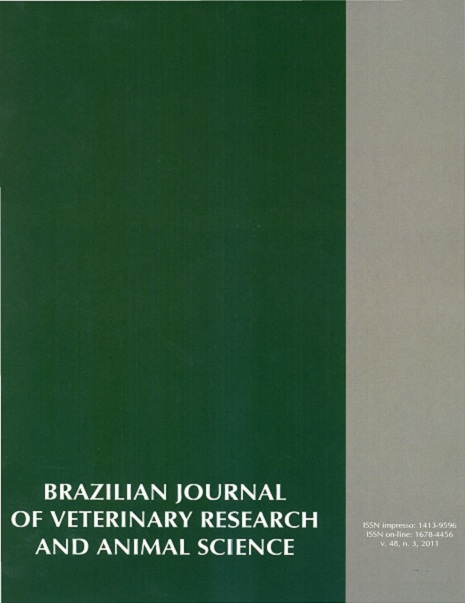Erythrogram and erythrocytes measurement of ostriches (Struthio camelus) in São José do Rio Preto-SP, Brazil
DOI:
https://doi.org/10.11606/S1413-95962011000300008Keywords:
Hematology, Red blood cell, Reference values, OstrichesAbstract
Ostriches' erythrocytic parameters help on the diagnosis of specific pathologies and serve as basic knowledge for studies in comparative avian pathology. To obtain reference values of erythrocyte indices for ostriches (Struthio camelus) raised in a commercial system in Brazil and verify if there are differences between gender and age groups, 240 healthy from both sexes animals were bled. Heparinized blood samples were analyzed using standard techniques to determine the red blood cell (RBC) count, hemoglobin concentration, packed cell volume (PCV), mean corpuscular volume (MCV), mean corpuscular hemoglobin (MCH), and mean corpuscular hemoglobin concentration (MCHC) values, besides the red cell morphometry analysis using a computer software that calculates the greater and the smaller diameters of the erythrocytes. Prior to data analysis, ostriches were divided into three different age groups: from four to 13 months, from 13 to 23 months and from 23 to 30 months the. Younger ostriches presented lower erythrocyte indices than the older ones. The age group effect was only significant in females for the erythrocyte, hemoglobin, MCV, MCH, and MCHC variables. The female ostriches presented PCV, MCV, MCH, and MCHC values significantly higher than males in some age groups. It was observed that the erythrocytes of the female ostriches are more elongated and larger than males. It was concluded that erythrocytic parameters of ostriches in São José do Rio Preto-SP, Brazil are influenced by gender and age, highlighting the importance of consider besides these factors also the geoclimatic conditions to an adequate interpretation of the erythrogram.Downloads
Download data is not yet available.
Downloads
Published
2011-06-01
Issue
Section
UNDEFINIED
License
The journal content is authorized under the Creative Commons BY-NC-SA license (summary of the license: https://
How to Cite
1.
Sabino AJ, Trevelin SC, Almeida BFM, Peiró JR, Ciarlini PC. Erythrogram and erythrocytes measurement of ostriches (Struthio camelus) in São José do Rio Preto-SP, Brazil. Braz. J. Vet. Res. Anim. Sci. [Internet]. 2011 Jun. 1 [cited 2024 Apr. 20];48(3):234-8. Available from: https://revistas.usp.br/bjvras/article/view/34387





